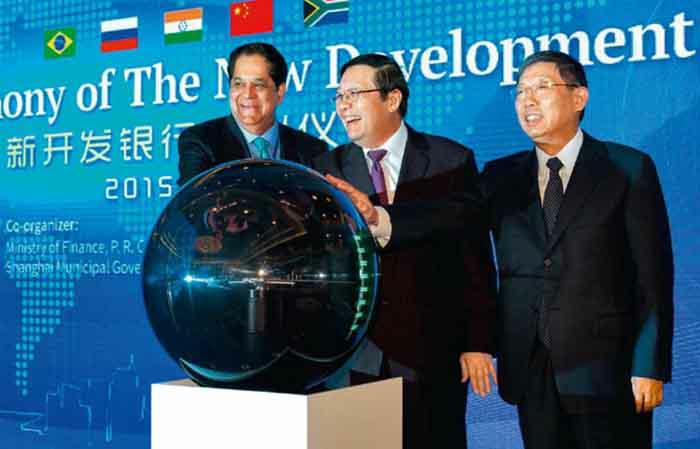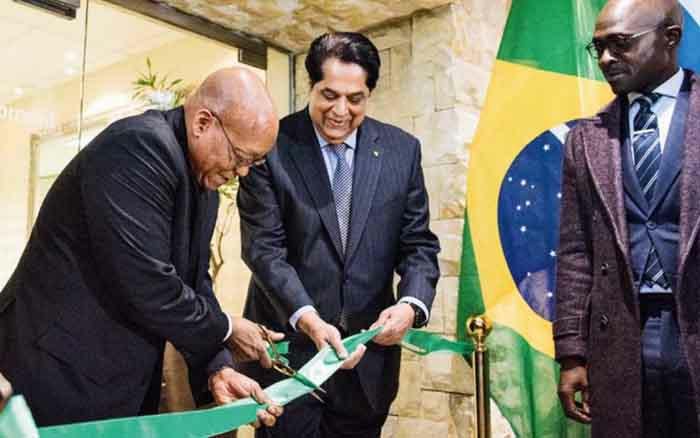The Widening Path of the NDB
2017-09-27byYeYu
by+Ye+Yu
The idea of establishing the New Development Bank (NDB), a multilateral development bank co-founded by BRICS nations, was introduced at the BRICS summit in New Delhi, India, in March 2012. According to the agreement, “the Bank shall mobilize resources for infrastructure and sustainable development projects in BRICS and other emerging economies and developing countries, complementing the existing efforts of multilateral and regional financial institutions for global growth and development.”After two years of negotiations, Agreement on the New Development Bank was signed in July 2014, and the bank officially opened for business in Shanghai in 2015.
The NDB was established in a certain context: First, a serious shortage of infrastructure construction funds was bottlenecking development. According to the Organization for Economic Cooperation and Development, global demand for infrastructure financing will reach US$50 trillion before 2030, 60 percent more than the total actual expenditures over the past two decades. Second, expansion of traditional multilateral development banks is hindered by political restraint. Since the 2008 economic recession, reforms on capital increase and voting rights promoted by the G20 group were limited, resulting in poor funding capacity for infrastructure construction.
The NDB is “new” because shared incentive is employed as a new practice, which attracts BRICS nations to contribute new funds, experience and knowledge on infrastructure financing to projects that benefit developing countries. In contrast with traditional multilateral development banks, the NDB has adopted a mechanism enabling equality in the decision-making process—and no country has veto power, which ensures open doors to the facilitation of cooperation among BRICS nations. BRICS states already control huge capital reserves. The foreign exchange reserves of BRICS nations also lead the world. Using modern financial instru- ments and governance structure, these funds will be “internally recycled” to more effectively contribute to infrastructure construction in developing countries and boost their productivity. Such factors have been cited by world-renowned economists including Nicolas Stern and Joseph Stigliz, who have expressed support for the establishment of the NDB.
Hitting the Ground Running
Two years after its inception, the NDB has been making steady progress, and its market status has been cemented preliminarily.endprint
First, the banks organizational structure and strategic planning have taken initial shape. Its first five-year plan (2017-2021) was approved by its Board of Directors. Basic policy frameworks in various fields including organizational governance, corruption deterrence, loans, procurement, environment and social standards are already in place. The bank now employs a staff of about 100, a figure that is expected to increase to 400 by 2021. The NDB attaches great importance to the recruitment of young employees, the ideal people to further innovate its development.
Second, the local currency financing process of BRICS nations has begun. The banks funds come from the five shareholders. The NDBs initial capital of US$50 billion was equally contributed by the five members. In 2016, the NDB issued its first green bond worth 3 billion yuan (about US$448 million) in the Chinese interbank bond market. This was the first time a multilateral development bank issued a green bond denominated in Chinese currency in China. The NDB also plans to raise US$300 million to US$500 million via rupee denominated masala bonds.
Third, the bank has reinforced its market position focused squarely on sustainable development and infrastructure construction. In 2016, the NDBs Board of Governors approved seven projects worth a total of more than US$1.5 billion. Of the seven projects, six are renewable energy programs. The only exception is a highway project in Indias Madhya Pradesh. In the next two to three years, the scale of NDB loans is expected to double annually. Two thirds of loans will go to “sustainable infrastructure,” meaning projects that will cause positive transformative benefits to both the environment and society. The other one third will be invested in “traditional infrastructure” to mitigate potential external risk.
Fourth, the NDB places emphasis on commercialization and efficient operations. The NDB features expanded commercial operations and lacks soft-loan windows. It has flexible financing methods including loans, stock equity, guarantees and co-financing. And its prospective borrowers are not limited to sovereign states. The NDB has no standing Board of Governors, and considers prospective borrowers policies, regulations and institutions to manage their loans, in principle, which greatly reduces administrative costs.
Local Roots
The NDB and the Asian Infrastructure Investment Bank(AIIB) are often mentioned in the same breath. Both banks are dedicated to mending defects in the existing international financial system, mobilizing funds in emerging economies and supporting infrastructure projects in developing countries. Moreover, both banks attach importance to flexible and efficient governance patterns. However, the two banks have gradually veered off on different development paths since their respective inceptions.endprint
As a platform to promote South-South cooperation, the NDB places more emphasis on localized development. The AIIB, which is more international, embodies Chinas pivotal role in promoting South-North cooperation. Along with the aforementioned financing localization, the NDBs focus on local development is maintained through the following steps:
First, employee recruitment and purchasing policies are localized. While all NDB employees hail from BRICS nations, the AIIB recruits international employees. In terms of the purchasing policy, the NDB, in principle, only make purchases from its members, while the AIIBs purchasing policy is open to the world.
Second, partnerships and standards are localized. The NDB has already signed memorandums of understanding with nine multilateral development banks to learn from their experience. According to NDB President K.V. Kamath, although his bank will seek co-financing projects, this realm will only account for a small proportion of the NDBs operations. The first seven projects approved by the NDB are all individual financing programs primarily supported by the governments of its five members.
Vigorous Growth
The NDB is a new institution. Its organization, governance and policies still have room to be tested, honed and improved. A stable marketplace for the NDB is expected to form within the next five to 10 years. Before that time, the bank needs to overcome the following major challenges.
First are problems of international credit ratings and financing costs. At present, although the NDB has received high credit ratings from Chinese rating agencies, reaching the top international rating has proved more difficult. Capital markets of BRICS nations still need improvement, costs for local financing are comparatively high, and unstable economic and political situations in some BRICS countries are challenges to be overcome to improve the NDBs financing capabilities.
Second, incomplete national governance systems bring risks. The NDB mainly relies on the borrowers national systems. While this practice can indeed enhance project efficiency, market supervision regulations of BRICS nations still need to be further improved because of the different national conditions and development stages of BRICS countries.
Third, the joint force of BRICS nations needs to be strengthened. If the five BRICS nations can collectively act as a powerful political force, the NDB will better explore local resources and realize developmental advantages. However, because competition between BRICS nations is so intense at present, distribution of relative gains has become a pressing problem. Optimal distribu- tion of resources among the five nations has yet to be satisfactorily realized, which increases the operational costs of the bank.
Inspired by the AIIBs membership expansion, the NDB also seeks to expand its membership to solve its problems and further develop. Contrasting the BRICS Summit which focuses on emerging economies and developing countries, the NDBs criteria for membership are more flexible and practical. According to the banks five-year plan, it should maintain a rational proportion of developed, middle-income and low-income countries when recruiting new members, evidencing that the bank is open to developed countries. The participation of new members will make the NDB more international. endprint
endprint